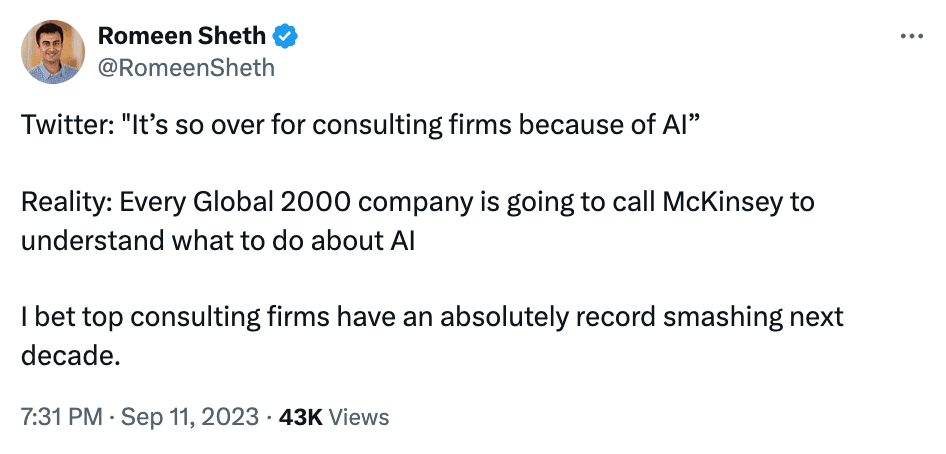AI and IT Services (Part I)

AI has generated a lot of buzz on how it's going to disrupt tech, with entrepreneurs and VCs going all in. But there’s surprisingly little on how it's going to impact the $1.2Tn IT Services industry, especially in terms of new companies starting in this space.
Paul Graham coined the term schlep blindness (opens in a new tab) to describe a common oversight among technical entrepreneurs, and their default path to avoid anything unpleasant like services which involves dealing with lots of humans.
Let’s explore the AI opportunities in IT Services from both demand and supply perspectives today,
Demand Side
From a demand side perspective, the opportunity is quite obvious, so I will keep this brief. Everyone is obsessed with Gen AI (especially CXOs). They desperately need help to ensure they don’t fall short and their stock price doesn’t tank, and so, they turn to consulting companies for whom this is the next big revenue driver. This includes consultants such as Bain and BCG, and technology implementation partners like Infosys.

Outside the hyperscalers and OpenAI (opens in a new tab) , the biggest Gen AI winner has probably been Accenture (opens in a new tab) (they are a hybrid of strategy and IT implementation), having booked $1Bn+ in Gen AI related orders in the last two quarters alone. (opens in a new tab)
I like to categorise AI related opportunities into broadly two types -
- Horizontal Specific: This includes Gen AI features for horizontal functions like marketing, HR and finance. An example could be building a sales Copilot for a company that aggregates data on prospects from various sources like LinkedIn and social media, and is able to create a customised pitch for cold email campaigns with an LLM. We have built this at Calsoft (opens in a new tab) , and have seen a dramatic increase in response rates from the customer.
- Vertical Specific: This means integrating Gen AI into industry-specific workflows. Vertical specific opportunities include model fine-tuning for an enterprise industry specific use case, open source model selection, implementation, and creation of data pipeline for RAG in the enterprise context. An example that I have come across with several healthcare AI startups is medical coding. In the complicated American healthcare system, standardised codes denote procedures, diagnoses, and operations. These codes facilitate communication among hospitals, doctors, insurers, and other healthcare players for billing and reimbursement purposes. However, there are often errors made by humans in translating medical terms into the standardised medical codes. The translation can often be subjective and requires medical knowledge. Clinicians tend to be overworked which leads to errors. Startups like Arintra Telemedicine (opens in a new tab) are using LLMs to analyse healthcare documentation like EHRs, and suggest clinical codes automatically, but you can also envision IT services companies building custom solutions for this.
Supply Side
This is where things get more interesting. There are broadly two schools of thought there. The first is that since AI is going to bring down the cost of writing code dramatically, clients don’t need to outsource anymore and therefore it’s all over for overpaid developers and IT Services companies who benefit from outsourced software development. This idea was especially popular in the early ChatGPT days, and keeps recurring when demos like Devin (opens in a new tab) surface on Twitter.
The second school of thought is one put forth by Benedict Evans (opens in a new tab) who cites Jevons Paradox as an example. Jevons Paradox is an economic theory which states that as technology reduces the cost and increases the efficiency of a resource, the overall demand goes up due to the fall in cost per unit. VisiCalc, the first spreadsheet program, was invented in 1979. Prior to that, accounting and finance departments had armies of people who did manual calculation of financial statements and accounting documents. That financial model that you built in Excel in a day probably took a team of 10 people over a month in 1978.
So with the invention of the spreadsheet (aka Excel “AI”), you would expect loads of accountants to be out of a job right?
Wrong.
As seen from the graph below, this had no discernible impact on hiring of new accountants and the graph has only gone up one way since 1979.

Accountants FTW
Pre-GPT, there were only 25M developers in the world. All the software used by consumers and enterprises was written by this select few. Post-GPT everyone has the basic powers of coding.


Conclusion
So as the cost of writing code dramatically decreases, and Jevons Paradox means that we will suddenly see an explosion of demand for technology as everything that was previously cost prohibitive to digitise can now be digitised, who are the winners and losers in IT Services?
My next article will cover the opportunity for new-age IT Services companies and how they should leverage Gen AI to win - and why traditional IT Services companies won't be able to take advantage of this.
As usual, please feel free to DM me on LinkedIn or email me at anshulbhide@gmail.com if you want to discuss IT Services, investing or anything else. We are also actively hiring AI engineers (opens in a new tab) at Calsoft, so please contact me if that's of interest.
Special thanks to Krishna Kulkarni (opens in a new tab) and Sid Puri (opens in a new tab) for reading early drafts of this!
Here is a link to my previous post on “Why don’t more VCs invest in IT Services.” (opens in a new tab)
© Anshul Bhide.RSS